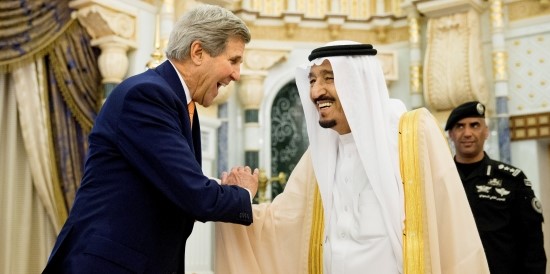S&P just downgraded Saudi Arabia 사우디 신용등급 강등
S&P just downgraded Saudi Arabia
S&P,
'AA-/A-1'+ → 'A+/A-1'
저유가 및 예멘공습 장기화 주요인
나머지 두 국제 신용평가사는 변동없어
source presstv.com
edited by kcontents
케이콘텐츠 편집
국제 신용평가사 스탠더드 앤드 푸어스(S&P)가 사우디아라비아의 국가 신용등급을 한 계단 낮췄다. S&P는 30일(현지시간) 사우디의 국가신용등급(외화·자국화 표시채권 발행등급·IDR)을 장기는 'AA-'에서 'A+'로, 단기는 'A-1+'에서 'A-1'으로 각각 한 계단씩 낮추고 등급 전망은 '부정적'으로 유지했다. S&P는 저유가 장기화에 따라 사우디의 올해 재정적자가 국내총생산(GDP)의 16%에 달할 것이라며 등급 강등 이유를 설명했다. 나머지 두 국제 신용평가사의 사우디 신용등급은 아직 변동이 없다. 무디스 장기 신용등급은 'Aa3'(등급 전망 '안정적')로 높고, 피치는 'AA'(등급 전망 '부정적')를 매겨 S&P보다 2단계 높다. 저유가가 회복될 기미가 보이지 않고 예멘 공습이 길어지면서 흔들릴 것 같지 않던 산유 부국 사우디 경제에 대한 부정적인 전망이 최근 부각되고 있다. 국제통화기금(IMF)은 지난 21일 낸 지역경제보고서에서 현재와 같은 저유가가 지속하고 사우디 정부가 긴축 재정, 세제 개혁을 단행하지 않으면 5년 안에 국가 재정이 고갈될 수 있다고 우려했다. 중동 최대 사우디 증시의 타다울 지수는 올해 초 대비 현재 15% 정도 떨어졌으며, 5년 만기 외국환평형기금채권(외평채)에 붙는 신용부도스와프(CDS) 가산금리(프리미엄)도 1.30%포인트(130bp)로 2012년 1월 이후 최고치다. 이는 필리핀(106bp 안팎)보다도 높다. CDS 프리미엄은 국가의 부도 위험을 나타내는 지표다. 사우디 중앙은행이 보유한 순외화자산도 지난해 8월 7천370억 달러에서 현재 6천470억 달러(약 737조원)로 줄어들었다. S&P의 강등 결정에 대해 사우디 정부는 강력히 반발했다. 사우디 재무부는 "S&P의 평가는 전체 국가 경제의 기초여건(펀더멘털)을 고려하지 않은, 자본시장과 유가에 대한 즉각적 반응 정도로 보인다"며 "사우디 경제의 기초는 여전히 튼튼하며 빠르게 성장하고 있다"고 반박했다.
이어 "사우디는 GDP의 100%가 넘는 순자산을 보유한 국가이고 외화보유고도 충분하다"며 "S&P의 평가는 매우 성급했고 경기 순환을 고려하지 않은 것이므로 이번 평가에 전혀 동의하지 않는다"고 덧붙였다. (두바이=연합뉴스) 강훈상 특파원 |
Khurais oilfield, Saudi Arabia oilAli Jarekji/Reuters
A gas flame is seen in the desert near the Khurais oilfield, about 160 km (99 miles) from Riyadh.
Myles Udland
Ratings agency S&P just downgraded Saudi Arabia's debt rating.
In a release on Friday, S&P cut its rating on Saudi Arabia's foreign- and local-currency sovereign credit ratings on Saudi Arabia to 'A+/A-1' from 'AA-/A-1+.' S&P's outlook for the kingdom remains negative.
In a release, S&P said a "pronounced negative swing" in Saudi Arabia's fiscal balance prompted the downgrade.
Over the 10 years ending in 2013, S&P noted that Saudi Arabia's budget surpluses — or money available after all government expenses had been met — averaged about 13% of GDP. This situation, however, has changed rapidly as the price of oil has crashed, and in 2015 Saudi Arabia is expected to see a budget deficit equal to 16% of GDP.
The main implication of a debt rating downgrade is that it becomes more expensive for an issuer to borrow money in the market.
In a separate report on Friday, analysts at RBC Capital Markets looked at what implications potential conflicts inside Saudi Arabia's ruling family could have for global oil markets.
In short, RBC noted that there have been growing reports of discontent within the royal family since the ascent of King Salman to the throne in January. The firm said that much of this conflict has been driven by the outsized influence Salman's favorite son, Deputy Crown Prince Mohammad bin Salman, has enjoyed.
RBC notes that the King's son, who is believed to be between 29 and 32 years old, "controls some of the most prized political real estate in the country despite having a shorter resume than many of his older relatives."
He is, however, third in line to the crown, with Crown Prince Muhammad bin Nayef, the 79-year-old king's nephew, currently next in line. But as Business Insider's Mike Bird noted, a grandson of Ibn Saud, who founded the Kingdom, recently published a series of letters calling for all three of them to be replaced.
S&P, for its part, notes that the power in Saudi Arabia effectively lies with the King, the Crown Prince, and the Deputy Crown Prince, and any tensions in or among the monarchy could pose problematic for Saudi Arabia's economy.
"In our view, reconciling intra-family issues around succession could make the kingdom's policy decisions more challenging and difficult to predict ... Broader institutional checks and balances are still at early stages of development," S&P wrote on Friday.

King SalmanReuters
U.S. Secretary of State John Kerry, left, shakes hands with Saudi Arabia's King Salman at the Royal Court, in Riyadh, Saudi Arabia.
Saudi Arabia, which is seen as the de facto leader of OPEC, the 12-member cartel of nations that get most of their revenue from the sale of oil, has been a driver of OPEC's strategy to continue flooding the market with oil in an effort to both receive as much revenue as possible from oil sales and drive prices lower to squeeze smaller US shale producers from the market.
So far, US shale has proved a bit more resilient than perhaps OPEC had expected when it announced last November that it would not curb production. OPEC is set to meet next on December 4.
And so it remains to be seen if the current power structure in place in Saudi Arabia will push for a shift in OPEC strategy, or if a change in power could be what triggers something new in the world's oil market.
http://www.businessinsider.com/sp-downgrades-saudi-arabia-debt-rating-2015-10
케이콘텐츠
kcontents
"from past to future"
데일리건설뉴스 construction news
콘페이퍼 conpaper
.










